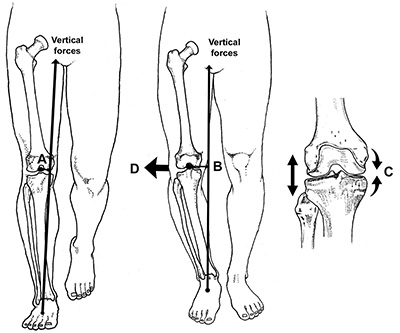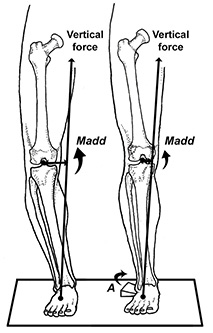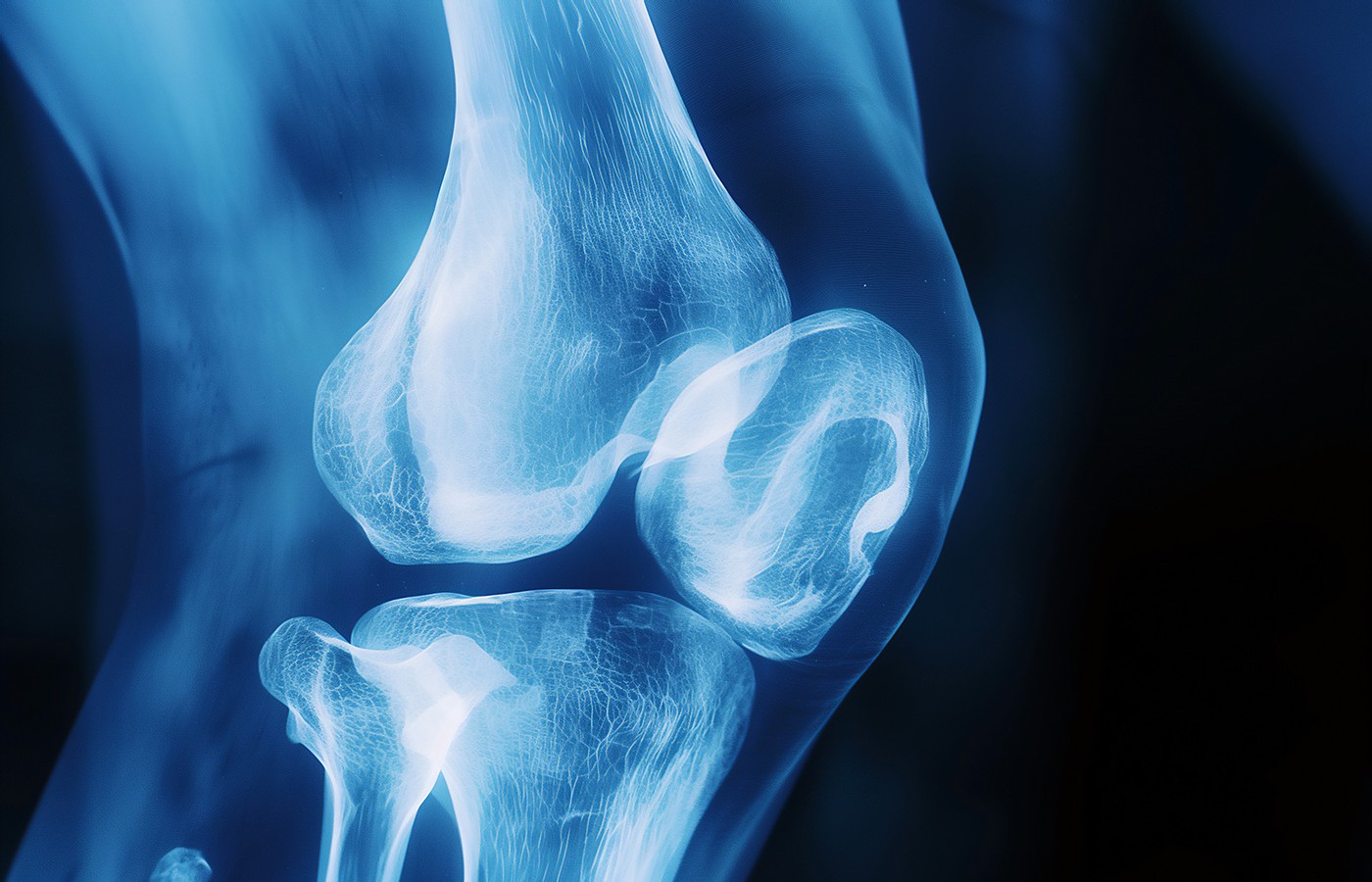New York's highest court of appeals has held that no-fault insurers cannot deny no-fault benefits where they unilaterally determine that a provider has committed misconduct based upon alleged fraudulent conduct. The Court held that this authority belongs solely to state regulators, specifically New York's Board of Regents, which oversees professional licensing and discipline. This follows a similar recent ruling in Florida reported in this publication.
Bowed Legs and Knee Arthritis
Tibial varum, or bowed legs, is a normal alignment pattern in toddlers that typically corrects itself by about age 2, when the knees gradually straighten and shift to a slight valgus alignment. A common cause of the development of bowed legs persisting into adulthood is the initiation of early walking when physiologic varum is at its peak (10-12 months).
The application of vertical forces when the legs are bowed can compress the medial knee joint so that growth at the medial tibial physis is inhibited (consistent with the Heuter-Volkmann principle). The resulting angular deformity only serves to amplify the compressive forces, worsening the varus alignment.
Bowed Legs: Consequences With Age
As bowlegged individuals get older, the added compressive force accelerates the development of medial knee osteoarthritis. As noted by Andriacchi,1 the medial side of the knee joint supports 60-70% of the knee’s total compressive load, which is estimated to be between 150-200% body weight while walking.

According to Tetsworth,2 as little as a 5 degrees bowing of the tibia can redistribute pressure so the medial knee supports as much as 90% of the total load borne by the knee (Fig. 1). This increased compressive force placed on the medial knee has the ability to significantly accelerate the development of osteoarthritis. In fact, evaluation of the rate of progression of medial knee arthritis in 237 individuals over an 18-month period confirmed that a varus angle exceeding 5 degrees increased the rate of progression by 400%.3
As the degree of medial knee arthritis worsens, individuals with bowed legs often develop a varus thrust gait, in which the entire knee shifts laterally during midstance. A varus thrust is almost always painful and notoriously difficult to treat.
Canes, Braces and Posts: Pros/Cons
To lessen the potential for developing medial knee arthritis with or without a varus thrust gait pattern, the increased pressure generated along the inner knee should be controlled early, and one of the easiest ways to do this is for people with bowed legs to use a cane in the opposite hand. A cane creates an opposing ground-reactive force that lessens medial joint compression. Unfortunately, very few people are willing to walk with a cane in the early stages of osteoarthritis.
An alternate technique to manage varus thrust gait is the prescription of a valgus unloader brace. This brace is comprised of lightweight graphite shells molded to the distal femur and proximal thigh, which are connected by an adjustable metal hinge that allows for variable degrees of valgus correction.

Although effective at reducing pain and walking tolerance,4-5 these braces are not without drawbacks, as they are often described by users as cumbersome, bulky and uncomfortable, and are therefore not well-tolerated (up to one third of patients using generic models discontinue using them within the first year5).
Another approach for managing genu varum is to place a valgus post beneath the heel (Fig. 2). As demonstrated by Kerrigan, et al.,6 5 degree and 10 degree rearfoot valgus posts lessen the adductor moments present at the knee by 6% and 8%, respectively. This is consistent with a clinical study by Crenshaw, et al.,7 that determined 5 degree valgus posts placed beneath the heel while walking lessen knee adductor moments by 7%.
Unfortunately, despite laboratory and clinical success, well-controlled clinical studies have failed to show significant improvement for valgus posts compared to controls.8 I typically recommend valgus posts on a trial basis, and if the person states they reduce symptoms, I have them place posts in all of their shoes.
Strengthening Exercises
While canes, braces and posts represent extrinsic methods for lessening adductor moment arms, an intrinsic method for lessening the development of medial knee osteoarthritis occurs when the hip abductor musculature and the iliotibial band are strong enough to create a compressive force capable of stabilizing the lateral knee (Fig. 3).

As demonstrated by Chang, et al.,9 the ability to generate a significant hip abduction moment during the gait cycle correlates with a reduced progression of medial tibiofemoral osteoarthritis. In an 18-month study of disease progression, these authors concluded the protective effect associated with hip strength was present regardless of age, sex, walking speed and most importantly, the degree of varus malalignment.
As a result, conservative management of excessive tibial varum should always include strengthening exercises for the gluteus maximus, medius, minimus and tensor fasciae latae muscles. Because squats and deep lunges place significant stress on the patellofemoral joint,10 it is important to strengthen the hip abductors with exercises that do not overload the knee.
Researchers from Thailand11 have proven that lateral step-ups very effectively strengthen the hip abductors and inner quads, while barely loading the knee at all. Curtsy lunges are also an excellent option, as they work the hip in a flexed position, which in addition to strengthening the hip abductors, also strengthens the upper cortex of the femoral neck, which is a common site for fracture in older adults.12
Hip Strength: Start Early
It should be emphasized that while strong hip abductors prevent progression of medial knee arthritis, they are not that effective once significant varus thrust has developed. As a result, it is important for people with even slightly bowed legs to keep their hips strong starting at an early age, which can be accomplished by performing hip exercises just twice a week.
In the presence of an extreme varus thrust, often the only effective treatment is total or partial knee replacement. While waiting for joint replacement, a few simple gait modifications can reduce discomfort when varus thrust is present.
Several studies have shown that it is possible to reduce load on the medial knee by walking with a shortened stride, switching from a heel to a forefoot strike pattern, and/or walking with a wider base of gait.13-14 These simple changes can appreciably reduce knee pain by reducing vertical loads present in the medial knee while walking. Ideally, bowlegged individuals can avoid getting to this point by committing to a long-term hip strengthening program when they are young.
References
- Andriacchi TP. Dynamics of knee malalignment. Orthop Clin North Am, 1994;25:395-403.
- Tetsworth K, Paley D. Malalignment and degenerative arthropathy. Orthop Clin North Am, 1994;25:367-77.
- Sharma L, Song J, et al. The role of knee alignment in disease progression and functional decline in knee osteoarthritis. JAMA, 2001;286:188-195.
- Kirkley A, Webster-Bogaert S, Litchfield R, et al. The effect of bracing on varus gonarthrosis. J Bone Joint Surg Am, 1999;81:539-48.
- Brouwer RW, van Raaij TM, Verhaar JA, et al. Brace treatment for osteoarthritis of the knee: a prospective randomized multi-centre trial. Osteoarthritis Cartilage, 2006;14:777-83.
- Kerrigan D, Lelas J, Goggins J, et al. Effectiveness of a lateral-wedge insole on knee varus torque in patients with knee osteoarthritis. Arch Phys Med Rehabil, 2002;83:889-93.
- Crenshaw SJ, Pollo FE, Calton EF. Effects of lateral- wedged insoles on kinetics at the knee. Clin Orthop Relat Res, 2000;375:185-92.
- Gross K, Hillstrom H. Knee osteoarthritis: primary care using noninvasive devices and biomechanical principles. Med Clin N Amer, 2009;93:179-200.
- Chang A, Hayes K, et al. Hip abduction moments and protection against medial tibiofemoral osteoarthritis progression. Arth Rheum, 2005;52:3515-3519.
- Powers C, Ho K, Chen Y, et al. Patellofemoral joint stress during weight-bearing and nonweightbearing quadriceps exercises. J Orthop Sports Phys Ther, 2014; 44:321-327.
- Chinkulprasert C, Vachalathiti R, Powers C. Patellofemoral joint forces and stress during forward step up, lateral step up, and forward step down exercises. J Orthop Sports Phys Ther, 2011 Apr;41:241-8.
- Mayhew P, Thomas C, Clement J, et al. Relation between age, femoral neck cortical stability, and hip fracture risk. The Lancet, 2005 Jul 9;366(9480):129-35.
- Bennett HJ, Zhang S, Shen G, et al. Effects of toe-in and wider step width in stair ascent with different knee alignments. Med Sci Sports Exerc, 2017 Mar 1;49:563-72.
- Ruder M, Jamison ST, Tenforde A, et al. Relationship of foot strike pattern and landing impacts during a marathon. Med Sci Sports Exerc, 2019 Oct 1;51(10):2073-9.



